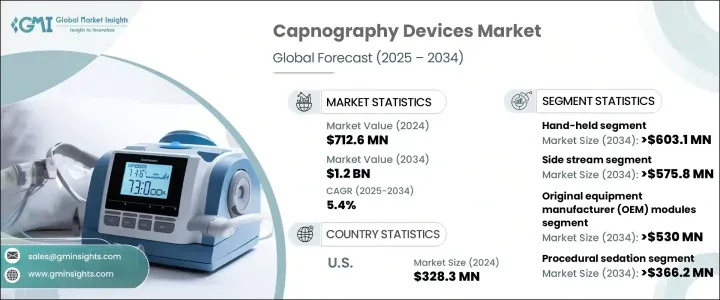
|
시장보고서
상품코드
1750540
카프노그래피 기기 시장 : 시장 기회, 성장 촉진요인, 산업 동향 분석, 예측(2025-2034년)Capnography Devices Market Opportunity, Growth Drivers, Industry Trend Analysis, and Forecast 2025 - 2034 |
||||||
세계의 카프노그래피 기기 시장 규모는 2024년에 7억 1,260만 달러로 평가되었고, 호흡기 질환 이환율 상승, 치명적인 케어 및 응급 현장에서의 사용 증가, 저침습 처치에 대한 취향 증가 등 몇 가지 요인에 의해 CAGR 5.4%로 성장할 전망이며, 2034년에는 12억 달러에 달할 것으로 예측되고 있습니다.
또, 카프노그래피 기기의 채용은 환자의 진정시에 사용을 의무화하는 규제나, 헬스 케어에 있어서의 선진 기술의 채용이라고 하는 지속적인 동향도 뒷받침하고 있습니다. 또한, 휴대형 카프노그래피 기기에 대한 수요 증가에 의해 이러한 장치는 외래 진료소, 구급 의료 서비스, 병원 이외의 환경에 적합하고, 시장의 성장을 더욱 한층 더 뒷받침하고 있습니다.

카프노그래피 기기 수요는 호기 중 이산화탄소(CO2) 농도를 모니터링하는 능력과 관련이 있으며, 이는 마취 및 치명적인 치료 과정에서 환자의 안전을 보장하는 데 매우 중요합니다. 이러한 기기는 실시간 모니터링에 필수적이며, 헬스케어 공급자는 호흡기 계통의 문제를 조기에 발견하고 효과적으로 대응할 수 있습니다. 시장의 성장은, 환자 중심 케어에 대한 주목의 고조와, 이러한 기기의 정밀도와 사용의 용이성을 향상시키는 기술의 진보에 의해서도 지탱되고 있습니다.
| 시장 범위 | |
|---|---|
| 시작 연도 | 2024년 |
| 예측 연도 | 2025-2034년 |
| 시작 금액 | 7억 1,260만 달러 |
| 예측 금액 | 12억 달러 |
| CAGR | 5.4% |
핸드헬드 분야는 CAGR 5%로 성장할 전망이며, 2034년까지 6억 310만 달러의 예측치로 크게 공헌할 전망입니다. 핸드헬드는 휴대성이 뛰어나 병원전이나 외래에서의 사용에 최적입니다.이러한 기기를 통해 헬스케어 공급자는 진정 및 호흡 모니터링이 필요한 조치 중 신속하고 충분한 정보를 바탕으로 의사결정을 할 수 있어 환자의 안전이 확보됩니다. 게다가 멀티 파라미터 시스템보다 비용 대비 효과가 높기 때문에 예산 중시의 헬스케어 현장에서 인기가 있습니다.
컴포넌트별로는 OEM(상대 브랜드 제조) 모듈이 CAGR 5.1%로 성장할 전망입니다. 이 모듈들은 멀티 파라미터 시스템에 통합되어 헬스케어 시설이 진단 능력을 강화하기 위한 비용 대비 효과적인 방법을 제공합니다. 컴팩트한 설계로 다른 플랫폼과 통합할 수 있기 때문에 다양한 헬스케어 환경에 적응할 수 있습니다. 상호운용성 및 개별 케어의 필요성이 OEM 모듈의 수요를 계속 끌어올리고 있어 전 세계 병원과 진단센터에서 지지를 받고 있습니다.
미국의 카프노그래피 기기 시장은 2024년에 3억 2,830만 달러로 평가되었으며, 앞으로도 상승 기조가 계속될 것으로 예상되고 있습니다. 이 배경에는 마취나 처치 진정의 카프노그래피 요건 등 강력한 규제 지원이 있습니다. 게다가 외래 수술이나 병원전의 케어에 있어서 카프노그래피의 채용 확대도 미국에서의 시장 확대에 기여하고 있습니다.
세계의 카프노그래피 기기 시장의 주요 기업으로는 ZOLL Medical, Medtronic, Philips Healthcare, Masimo Corporation, Becton, Dickinson and Company 등이 있습니다. 이러한 기업은 전략적 제휴, 제품 혁신, 보다 선진적이고 휴대 가능하고 비용 효율적인 솔루션을 제공함으로써 시장에서의 지위를 강화하고 있습니다. 환자의 안전성 향상 및 사용의 용이성을 요구하는 고객 요구에 주력하는 것으로, 이러한 기업은 시장에서의 존재감을 높이고 있습니다.
목차
제1장 조사 방법 및 범위
제2장 주요 요약
제3장 업계 인사이트
- 생태계 분석
- 업계에 미치는 영향요인
- 성장 촉진요인
- 저침습 수술 증가
- 호흡기 질환 증가
- 산소 농도계보다 카프노미터가 선호되는 경향
- 최근의 기술 진보 및 정부의 바람직한 대처
- 성형수술 증가
- 업계의 잠재적 위험 및 과제
- 숙련된 전문가의 부족
- 기기의 고비용
- 엄격한 규제 지침
- 성장 촉진요인
- 성장 가능성 분석
- 규제 상황
- 트럼프 정권에 의한 관세에 대한 영향
- 무역에 미치는 영향
- 무역량의 혼란
- 보복 조치
- 업계에 미치는 영향
- 공급측의 영향(원재료)
- 주요 원재료의 가격 변동
- 공급망 재구성
- 생산 비용에 미치는 영향
- 수요측의 영향(판매가격)
- 최종 시장에 대한 가격 전달
- 시장 점유율 동향
- 소비자의 반응 패턴
- 공급측의 영향(원재료)
- 영향을 받는 주요 기업
- 전략적인 업계 대응
- 공급망 재구성
- 가격 설정 및 제품 전략
- 정책관여
- 전망 및 향후 검토 사항
- 무역에 미치는 영향
- 기술의 상황
- 갭 분석
- Porter's Five Forces 분석
- PESTEL 분석
- 장래 시장 동향
- 밸류체인 분석
제4장 경쟁 구도
- 서문
- 기업 매트릭스 분석
- 주요 시장 기업의 경쟁 분석
- 경쟁 포지셔닝 매트릭스
- 전략 대시보드
제5장 시장 추계 및 예측 : 제품별(2021-2034년)
- 주요 동향
- 핸드 헬드
- 독립형
- 멀티 파라미터
제6장 시장 추계 및 예측 : 기술별(2021-2034년)
- 주요 동향
- 부류
- 주류
- 마이크로스트림
제7장 시장 추계 및 예측 : 컴포넌트별(2021-2034년)
- 주요 동향
- OEM 모듈
- 기타 컴포넌트
제8장 시장 추계 및 예측 : 용도별(2021-2034년)
- 주요 동향
- 처치 진정
- 응급 의료
- 집중 치료
- 통증 관리
- 기타 용도
제9장 시장 추계 및 예측 : 최종 용도별(2021-2034년)
- 주요 동향
- 병원
- 외래수술센터(ASC)
- 기타 용도
제10장 시장 추계 및 예측 : 지역별(2021-2034년)
- 주요 동향
- 북미
- 미국
- 캐나다
- 유럽
- 독일
- 영국
- 프랑스
- 스페인
- 이탈리아
- 네덜란드
- 아시아태평양
- 중국
- 일본
- 인도
- 호주
- 한국
- 라틴아메리카
- 브라질
- 멕시코
- 아르헨티나
- 중동 및 아프리카
- 남아프리카
- 사우디아라비아
- 아랍에미리트(UAE)
제11장 기업 프로파일
- Becton, Dickinson and Company
- Criticare Systems
- Dragerwerk
- Edan Instruments
- Infinium Medical
- Masimo Corporation
- Medtronic
- Mindray Medical
- Nihon Kohden
- Nonin Medical
- Phillips Healthcare
- Shenzhen Comen Medical Instruments
- Smiths Medical
- ZOLL Medical
The Global Capnography Devices Market was valued at USD 712.6 million in 2024 and is estimated to grow at a CAGR of 5.4% to reach USD 1.2 billion by 2034, driven by several factors, including the rising incidence of respiratory diseases, increased use in critical care and emergency settings, and the growing preference for minimally invasive procedures. The adoption of capnography devices is also fueled by regulations that require their use during patient sedation, along with the ongoing trend of adopting advanced technologies in healthcare. Additionally, the increased demand for portable capnography units has made these devices suitable for outpatient clinics, emergency medical services, and non-hospital environments, further propelling market growth.

The demand for capnography devices is linked to their ability to monitor carbon dioxide (CO2) levels in exhaled breath, which is crucial for ensuring patient safety during anesthesia and critical care procedures. These devices are essential for real-time monitoring, allowing healthcare providers to detect respiratory issues early and respond effectively. The market's growth is also supported by the increasing focus on patient-centered care and technological advancements that improve the accuracy and ease of use of these devices.
| Market Scope | |
|---|---|
| Start Year | 2024 |
| Forecast Year | 2025-2034 |
| Start Value | $712.6 Million |
| Forecast Value | $1.2 Billion |
| CAGR | 5.4% |
The handheld segment is expected to grow at a 5% CAGR and contribute significantly with a projected value of USD 603.1 million by 2034. Handheld capnography devices are favored for their portability, making them ideal for use in pre-hospital care and ambulatory settings. These devices allow healthcare providers to make quick, informed decisions during procedures that require sedation or respiratory monitoring, ensuring patient safety. Moreover, their cost-effectiveness over multi-parameter systems drives their popularity in budget-conscious healthcare settings.
Based on components, OEM (Original Equipment Manufacturer) modules are expected to grow at a CAGR of 5.1%. These modules are integrated into multi-parameter systems, offering a cost-effective way for healthcare facilities to enhance their diagnostic capabilities. Their compact design and ability to integrate with other platforms make them highly adaptable for various healthcare environments. The need for interoperability and personalized care continues to push the demand for OEM modules, which are gaining traction in hospitals and diagnostic centers worldwide.
U.S. Capnography Devices Market was valued at USD 328.3 million in 2024 and is expected to continue its upward trajectory. This is due to strong regulatory support, including the requirement for capnography in anesthesia and procedural sedation. Additionally, the growing adoption of capnography in outpatient surgeries and pre-hospital care contributes to the market's expansion in the U.S.
Key players in the Global Capnography Devices Market include companies such as ZOLL Medical, Medtronic, Philips Healthcare, Masimo Corporation, and Becton, Dickinson and Company. These companies are strengthening their market positions through strategic collaborations, product innovations, and offering more advanced, portable, and cost-effective solutions. By focusing on customer needs for improved patient safety and ease of use, these companies are increasing their market presence.
Table of Contents
Chapter 1 Methodology and Scope
- 1.1 Market scope and definitions
- 1.2 Research design
- 1.2.1 Research approach
- 1.2.2 Data collection methods
- 1.3 Base estimates and calculations
- 1.3.1 Base year calculation
- 1.3.2 Key trends for market estimation
- 1.4 Forecast model
- 1.5 Primary research and validation
- 1.5.1 Primary sources
- 1.5.2 Data mining sources
Chapter 2 Executive Summary
- 2.1 Industry 3600 synopsis
Chapter 3 Industry Insights
- 3.1 Industry ecosystem analysis
- 3.2 Industry impact forces
- 3.2.1 Growth drivers
- 3.2.1.1 Growing number of minimally invasive surgeries
- 3.2.1.2 Rising number of respiratory diseases
- 3.2.1.3 Surging preference for capnometers over oximetry
- 3.2.1.4 Recent technological advancements coupled with favorable government initiatives
- 3.2.1.5 Increasing number of plastic surgeries
- 3.2.2 Industry pitfalls and challenges
- 3.2.2.1 Lack of skilled professionals
- 3.2.2.2 High cost of the device
- 3.2.2.3 Stringent regulatory guidelines
- 3.2.1 Growth drivers
- 3.3 Growth potential analysis
- 3.4 Regulatory landscape
- 3.5 Trump administration tariffs
- 3.5.1 Impact on trade
- 3.5.1.1 Trade volume disruptions
- 3.5.1.2 Retaliatory measures
- 3.5.2 Impact on the Industry
- 3.5.2.1 Supply-side impact (raw materials)
- 3.5.2.1.1 Price volatility in key materials
- 3.5.2.1.2 Supply chain restructuring
- 3.5.2.1.3 Production cost implications
- 3.5.2.2 Demand-side impact (selling price)
- 3.5.2.2.1 Price transmission to end markets
- 3.5.2.2.2 Market share dynamics
- 3.5.2.2.3 Consumer response patterns
- 3.5.2.1 Supply-side impact (raw materials)
- 3.5.3 Key companies impacted
- 3.5.4 Strategic industry responses
- 3.5.4.1 Supply chain reconfiguration
- 3.5.4.2 Pricing and product strategies
- 3.5.4.3 Policy engagement
- 3.5.5 Outlook and future considerations
- 3.5.1 Impact on trade
- 3.6 Technology landscape
- 3.7 Gap analysis
- 3.8 Porter's analysis
- 3.9 PESTEL analysis
- 3.10 Future market trends
- 3.11 Value chain analysis
Chapter 4 Competitive Landscape, 2024
- 4.1 Introduction
- 4.2 Company matrix analysis
- 4.3 Competitive analysis of major market players
- 4.4 Competitive positioning matrix
- 4.5 Strategy dashboard
Chapter 5 Market Estimates and Forecast, By Product, 2021 - 2034 ($ Mn)
- 5.1 Key trends
- 5.2 Hand-held
- 5.3 Stand-alone
- 5.4 Multi-parameter
Chapter 6 Market Estimates and Forecast, By Technology, 2021 - 2034 ($ Mn)
- 6.1 Key trends
- 6.2 Side stream
- 6.3 Main stream
- 6.4 Micro stream
Chapter 7 Market Estimates and Forecast, By Component, 2021 - 2034 ($ Mn)
- 7.1 Key trends
- 7.2 Original equipment manufacturer (OEM) modules
- 7.3 Other components
Chapter 8 Market Estimates and Forecast, By Application, 2021 - 2034 ($ Mn)
- 8.1 Key trends
- 8.2 Procedural sedation
- 8.3 Emergency medicine
- 8.4 Critical care
- 8.5 Pain management
- 8.6 Other applications
Chapter 9 Market Estimates and Forecast, By End Use, 2021 - 2034 ($ Mn)
- 9.1 Key trends
- 9.2 Hospitals
- 9.3 Ambulatory surgical centers
- 9.4 Other end use
Chapter 10 Market Estimates and Forecast, By Region, 2021 - 2034 ($ Mn)
- 10.1 Key trends
- 10.2 North America
- 10.2.1 U.S.
- 10.2.2 Canada
- 10.3 Europe
- 10.3.1 Germany
- 10.3.2 UK
- 10.3.3 France
- 10.3.4 Spain
- 10.3.5 Italy
- 10.3.6 Netherlands
- 10.4 Asia Pacific
- 10.4.1 China
- 10.4.2 Japan
- 10.4.3 India
- 10.4.4 Australia
- 10.4.5 South Korea
- 10.5 Latin America
- 10.5.1 Brazil
- 10.5.2 Mexico
- 10.5.3 Argentina
- 10.6 Middle East and Africa
- 10.6.1 South Africa
- 10.6.2 Saudi Arabia
- 10.6.3 UAE
Chapter 11 Company Profiles
- 11.1 Becton, Dickinson and Company
- 11.2 Criticare Systems
- 11.3 Dragerwerk
- 11.4 Edan Instruments
- 11.5 Infinium Medical
- 11.6 Masimo Corporation
- 11.7 Medtronic
- 11.8 Mindray Medical
- 11.9 Nihon Kohden
- 11.10 Nonin Medical
- 11.11 Phillips Healthcare
- 11.12 Shenzhen Comen Medical Instruments
- 11.13 Smiths Medical
- 11.14 ZOLL Medical



















